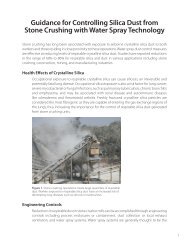Hazards in the Workplace - Occupational Knowledge International
Hazards in the Workplace - Occupational Knowledge International
Hazards in the Workplace - Occupational Knowledge International
You also want an ePaper? Increase the reach of your titles
YUMPU automatically turns print PDFs into web optimized ePapers that Google loves.
<strong>Hazards</strong> <strong>in</strong> <strong>the</strong> <strong>Workplace</strong><br />
Fact Sheet: Silica Dust and Respiratory disease<br />
With <strong>the</strong> boom <strong>in</strong> construction go<strong>in</strong>g on around Sydney, we often see workers <strong>in</strong> excavators<br />
digg<strong>in</strong>g <strong>in</strong> a cloud of dust. Or you may see construction workers drill<strong>in</strong>g or cutt<strong>in</strong>g <strong>in</strong>to concrete<br />
with no respiratory protection.<br />
These workers are at high risk of develop<strong>in</strong>g silicosis, a serious lung disease caused by <strong>the</strong><br />
accumulation of silica dust <strong>in</strong> <strong>the</strong> lungs. The scarr<strong>in</strong>g of <strong>the</strong> lungs and its stiffen<strong>in</strong>g will obstruct<br />
breath<strong>in</strong>g and cause shortness of breath. This can lead to permanent heart and lung disease.<br />
WHAT IS SILICA DUST?<br />
Silica is <strong>the</strong> ma<strong>in</strong> component <strong>in</strong> sand and <strong>in</strong> rocks like sandstone and granite. Many workplaces<br />
are not aware that common build<strong>in</strong>g products such as clay bricks, concrete, tiles and fibro<br />
cement products conta<strong>in</strong> silica. Silica dust is usually created when such build<strong>in</strong>g products,<br />
sandstone or rocks are cut, drilled or worked on <strong>in</strong> a way that creates f<strong>in</strong>e particles of silica <strong>in</strong><br />
<strong>the</strong> air. It is breath<strong>in</strong>g <strong>in</strong> this crystall<strong>in</strong>e form (quartz) of silica that causes silicosis.<br />
WHO IS AFFECTED?<br />
Silicosis is not a naturally occurr<strong>in</strong>g disease. Its development is directly associated with<br />
workplace exposure to silica dust. Workers who are mostly at risk <strong>in</strong>clude those engaged <strong>in</strong><br />
tunnel<strong>in</strong>g and excavation work, road build<strong>in</strong>g, demolition work as well as those <strong>in</strong> slate, granite<br />
cutt<strong>in</strong>g <strong>in</strong>dustries and some manufactur<strong>in</strong>g processes.<br />
HEALTH AFFECTS OF SILICA DUST<br />
Initial exposure to silica dust will cause irritation of <strong>the</strong> eyes, nose and throat like most o<strong>the</strong>r<br />
dusts. However, if excessive amounts of silica dust are brea<strong>the</strong>d <strong>in</strong>to <strong>the</strong> lungs over a period of<br />
time, it can cause damage to <strong>the</strong> lung tissue. O<strong>the</strong>r than some breathlessness dur<strong>in</strong>g exercise,<br />
<strong>the</strong> disease can rema<strong>in</strong> free of symptoms for 10-20 years after exposure.<br />
The most common form of silicosis develops after long exposure to relatively low<br />
concentrations. Once <strong>the</strong> disease has begun, it will progress slowly but relentlessly even if <strong>the</strong><br />
worker is removed from fur<strong>the</strong>r exposure. There is no medical treatment for silicosis. People<br />
with silicosis are also at greater risk of develop<strong>in</strong>g lung cancer. In 1996 <strong>the</strong> <strong>International</strong><br />
Agency for Research on Cancer classified crystall<strong>in</strong>e silica dust as a human carc<strong>in</strong>ogen (Group<br />
1).<br />
Silica factsheet - Unionsafe New Southwales.doc Page 1
HOW TO CONTROL SILICA DUST AT WORK<br />
The only effective protection aga<strong>in</strong>st silicosis is to prevent silica dust <strong>in</strong> <strong>the</strong> air. Under <strong>the</strong>ir<br />
obligations <strong>in</strong> <strong>the</strong> <strong>Occupational</strong> Health and Safety Act, employers must take measures to ensure<br />
that workers are not exposed to silica dust. There a number of simple control measures that<br />
can be taken.<br />
• Use a water hose to wet dust down at <strong>the</strong> po<strong>in</strong>t of dust generation. Water can be used<br />
through non-electric cutt<strong>in</strong>g or gr<strong>in</strong>d<strong>in</strong>g tools to reduce <strong>the</strong> dust <strong>in</strong> <strong>the</strong> air.<br />
• If it has to be a dry process, a dust control system with a suitable capture velocity can be<br />
used to extract silica dust.<br />
• Encourage good work practices to m<strong>in</strong>imise exposures to nearby workers or <strong>the</strong> public, <strong>in</strong><br />
some cases.<br />
Dust levels <strong>in</strong> <strong>the</strong> air should be monitored by a competent person. The exposure limit for silica<br />
dust (respirable quartz) is 0.1 mg/m3. However, exposure levels <strong>in</strong> sett<strong>in</strong>gs like construction<br />
sites are highly variable and air sampl<strong>in</strong>g alone is not enough to <strong>in</strong>dicate <strong>the</strong> health risks from<br />
airborne silica dust.<br />
In some build<strong>in</strong>g work, silica dust problems can be elim<strong>in</strong>ated by us<strong>in</strong>g pre-built materials for<br />
plumb<strong>in</strong>g and wir<strong>in</strong>g.<br />
Respirators should not be <strong>the</strong> primary method of protect<strong>in</strong>g aga<strong>in</strong>st silica dust. A suitable type<br />
of respirator may be used until adequate dust controls are put <strong>in</strong> place. Workers must be<br />
tra<strong>in</strong>ed <strong>in</strong> <strong>the</strong>ir proper use and ma<strong>in</strong>tenance.<br />
ARE MEDICAL TESTS NECESSARY?<br />
The disease is difficult to detect at <strong>the</strong> early stages because of <strong>the</strong> absence of symptoms.<br />
However, chest x-rays can help identify some of <strong>the</strong> cases and hopefully reduce <strong>the</strong> severity of<br />
disease.<br />
As a preventive measure, medical monitor<strong>in</strong>g should be available to those workers <strong>in</strong><br />
occupations where <strong>the</strong>y may be exposed to crystall<strong>in</strong>e silica. These should be done before job<br />
placement and at least every 3 years <strong>the</strong>reafter. High-risk jobs should be given annual medical<br />
exam<strong>in</strong>ations.<br />
This Fact Sheet is courtesy of <strong>the</strong> Workers Health Centre<br />
Silica factsheet - Unionsafe New Southwales.doc Page 2







